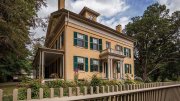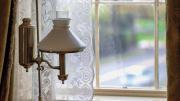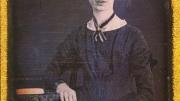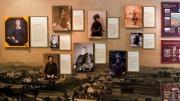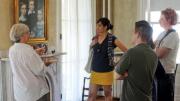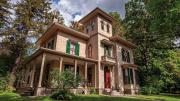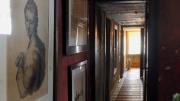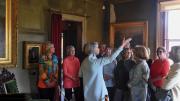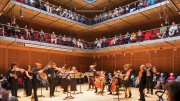In a small New England town, sitting at a plain wooden table, 17 3/8ths inches square, Emily Dickinson created nearly 1,800 poems that continue to entrance and mystify readers across the globe.
That table will again be on display at Harvard’s Houghton Library, known for its Dickinson collection, when building renovations are completed this fall. But far more riveting is seeing its replica within the context of her intensely private domain: her bedroom at The Emily Dickinson Museum, in Amherst, Massachusetts.
The restored room, along with the parlor, library, and conservatory, is part of the guided tour that starts as a literary pilgrimage of sorts at The Homestead, where Dickinson spent most of her life. From there visitors move across a broad lawn, through old trees, to an Italianate-style home, The Evergreens, that is a virtual nineteenth-century time capsule—down to the wood stove, toilet closet, and nursery bedroom—of the way it was when Dickinson’s older brother, Austin, and his wife, Susan Gilbert Dickinson, lived there. Together, the structures and the family stories help shed some light on the elusive poet.
Dickinson rarely left The Homestead and its grounds during her last two decades, often speaking to visitors from behind her bedroom door and communicating through copious letters. “The thought of sitting at that desk toiling away seems painful,” allows museum public-relations coordinator Emily Lackey, “but there is a sort of focus that I imagine would happen as a result.”
English poet and academic Malcolm Guite thought so, too. He saw the room in 2016 and “was filled with wonder at how much had flowed from so small a space,” his blog notes, “but then I thought about Dickinson’s characteristically concentrated and terse verse forms; those compact and concentrated little quatrains with the emphatic dashes linking and yet binding in the energy of her phrases, and it seemed to me the smallness of the desk was itself part of the form of the poetry, part of her gift.”
So, it seems, are the large windows of her corner room, through which light pours throughout the day. And the wallpaper: a vivid pattern of entwined wild pink roses, now reproduced based on an excavated scrap. Much of Dickinson’s poetry explores death, grief, nature, and an unearthly spirituality. She could be highly theatrical, and self-referential. Questions about her physical and mental health have long spurred speculation: was she a depressive? Bipolar? Agoraphobic? “There’s talk about her as this quiet, meek ‘spinster’ who was a recluse, and lived this sort of terrified life,” Lackey points out. But seeing the vibrancy of her restored room, and learning of her devotion, and playful writings, to a circle of family and friends, reveal that hers was “not a sort of dark and humble life. It was really bright and beautiful.”
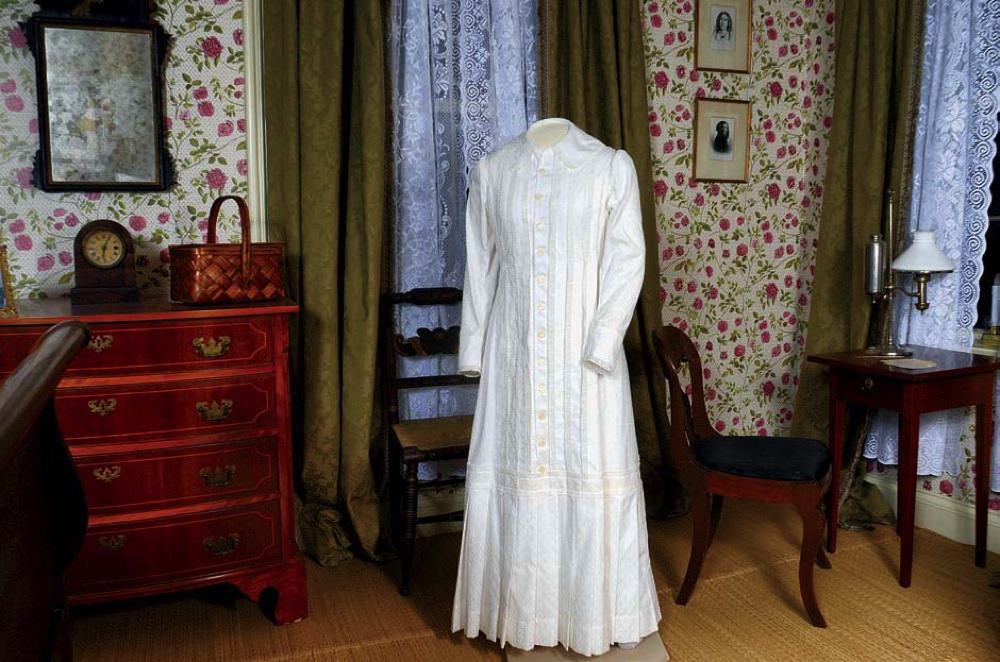
A copy of one of Dickinson’s iconic white dresses
Photograph courtesy of the Emily Dickinson Museum
Through her windows, Dickinson would have viewed a sweeping meadow and The Evergreens’ picturesque landscape. She was a passionate amateur botanist, as a teenager collecting more than 400 specimens and pressing them into her Herbarium (also at Houghton), and a lifelong gardener. Her father built her a small conservatory on the side of the house, where she tended calla lilies, gardenias, and inland buttercups. Nature, as The Gardens of Emily Dickinson, by Judith Farr, indicates, lent vitality and endless inspiration: one-third of Dickinson’s poems, and half her letters, mention her favorite flowers. Often, she records the most precious, minute observations: “A Bird, came down the Walk -/He did not know I saw -/He bit an Angle Worm in halves /And ate the fellow, raw,/ And then, he drank a Dew/From a convenient Grass -/And then hopped sidewise to the Wall/To let a Beetle pass –….” [This Dickinson text—#359—and #1696 and #1091 below, are from R.W. Franklin, The Poems of Emily Dickinson (Belknap Press of Harvard University Press, 1998).]
From her perch, Dickinson could also glimpse Amherst’s town center, although that vista was likely a mere backdrop to the infinitely more compelling world of her own mind. “There is a solitude of space/A solitude of sea/A solitude of Death, but these/Society shall be/Compared with that profounder site/That polar privacy/A soul admitted to itself-.”
Tours of The Homestead, opening for the season on February 28, also stop in the “poetry room” (likely the former bedroom of Emily’s sister, Lavinia), to convey a sense of how revolutionarily different Dickinson’s verses were from those of her more floridly descriptive contemporaries like Henry Wadsworth Longfellow. Highlighting her process (and supporting the notion that she herself sometimes created different versions of essentially the same poems) a wall exhibit depicts her line “A chilly Peace infests the Grass,” showing how she’d marked the manuscript with asterisked potential replacements for “chilly”—“warning” or “lonesome”—and how they completely shift the poem’s meaning. Because different people later transcribed and edited her work, it can be impossible to track the original intent (or intents).
Downstairs, another exhibit displays a copy of the only verified daguerreotype of the poet, taken when she was a teenager, and spotlights a few replicas of her handwritten poems and letters. It also tells the basic story of her life, explaining key Dickinson family members and the complex dynamics surrounding the posthumous publication of her work.
Her father, Edward, was a reserved man, prominent lawyer, and state representative; her mother, Emily Norcross Dickinson, a talented gardener, was apparently quite aloof, at least at times, in her daughter’s eyes. For years, she suffered from a mysterious ailment, and was later bedridden from a stroke and a broken hip. Both daughters tended her (Emily’s room connected to hers by a passage).
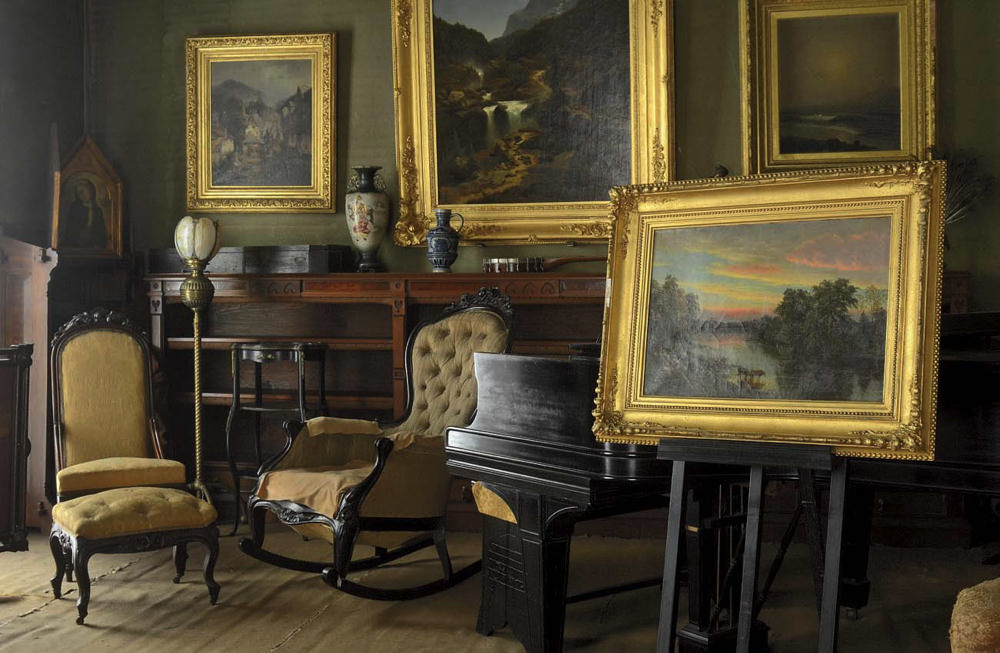
With its unusualy large collection of period art and objects, The Evergreens is a virtual nineteenth-century time capsule.
Photograph courtesy of the Emily Dickinson Museum
In contrast to Dickinson’s quiet life, Austin and Susan lived gregariously with their three children at The Evergreens. A girlhood friend of Emily’s, Susan was the reigning emotional, and possibly erotic, center of her life. Nothing at the museum characterizes their relationship that way, but guides do address it on the tour. “Emily’s correspondence to Susan in their late teens and early twenties was highly charged and, I think, clearly shows someone who is in love,” says museum executive director Jane Wald. “We don’t have the other side of that correspondence, so we don’t know what Susan’s frame of mind was.” (Complicating matters later, the exhibit notes, was the scandalous affair between Austin and Mabel Loomis Todd, an Amherst faculty wife, begun in 1882.)
Friends and family knew Dickinson was a poet: she saw maybe 10 poems published, and sent up to 500 to people (more than 250 to Susan alone). Yet only after Dickinson’s death from Bright’s disease in 1886 did her sister find the volume of works that today form her legacy. “Some of them were on chocolate wrappers and the backs of recipes,” Lackey says—Dickinson was a devoted baker—and 800 were neatly penned in 40 fascicles: delicate, stringed booklets that Dickinson created between 1858 and 1865.
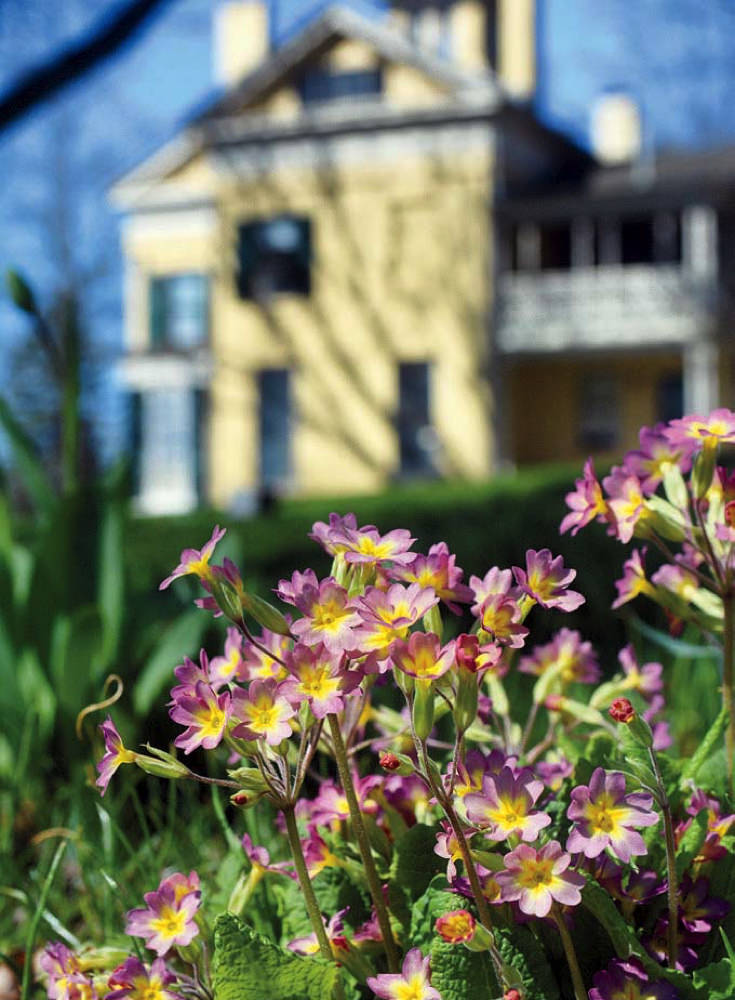
Blooming Primula at The Homestead. The museum plans to reproduce some of Dickinson’s own robust gardens eventually.
Photograph courtesy of the Emily Dickinson Museum
Lavinia saw their literary value, and asked Susan Dickinson first, and then Mabel Loomis Todd, to help publicize them. Todd and prominent literary critic Thomas Wentworth Higginson, A.B. 1841, edited a batch—changing Dickinson’s signature spacing, sparseness, and punctuation, and adding titles—for publication in 1890. Todd then produced two more volumes before an acrimonious legal fight over the fate of Dickinson’s poems ensued that ultimately delayed their publication in full until 1955. Despite the liberties taken, Lackey says that, without that initial push and Higginson’s professional stature, Dickinson’s unorthodox poems “likely would not have the fame that they do today.”
At Dickinson’s request, Lavinia burned her sister’s personal papers. But, puzzlingly, despite preparing the fascicles, Dickinson never specified what to do with them. During her most creative period she had initiated a correspondence with Higginson—famously asking, in 1862: “Are you too deeply occupied to say if my Verse is alive?”—that would last until she died. In one letter, she described herself: “I am small, like the wren, and my hair is bold, like the chestnut bur, and my eyes like the sherry in the glass that the guest leaves.” In another, she alluded to his support of her writing as saving her life. Yet she coyly danced around publication, and refused his invitation to travel to discuss it—“I do not cross my Father’s ground to any House or town”—instead inviting him to Amherst. In 1868, he came, and found her to be a plain woman dressed in white, writing later that he had never met “with any one who drained my nerve power so much. Without touching her, she drew from me. I am glad not to live near her.”
As Dickinson retreated, her brother’s house next door became a “hot spot in mid 1800s Amherst,” Lackey notes. Austin practiced law with his father, and later became the Amherst College treasurer; Susan was known as a highly capable and intelligent woman—and a careful, valued reader of Dickinson’s poems. The couple entertained, enjoying an intellectual, “high-society life” in the bustling college town. Their art-filled home reflected European works—a replica of Antonio Canova’s sculpture of Cupid and Psyche over a marble fireplace—and paintings echoing the Hudson River School; the roughly 8,000 objects represent a relatively rare assemblage of a nineteenth-century household, Wald notes. The pieces stand intact with the vintage wallpaper, amid streaks of dust and soot, and plaster, crumbling in spots. In the room of their younger son, Gib (Emily Dickinson’s much-loved nephew), who died of typhoid fever as a child, his jacket is neatly folded across the little bed. Their daughter, Martha Dickinson Bianchi, kept the house, living among the relics, until she died in 1943. Her heirs eventually established a trust to ensure its preservation and use as a “cultural facility.” The Homestead and The Evergreens were merged to form The Emily Dickinson Museum in 2003.
Yet even as The Evergreens and family tales contextualize Dickinson’s art and life, she herself can never be fully known—just as her writings are continually reread to reveal new facets. As a late poem implies, her own “room,” her universe—or maybe anyone’s interiority—was all there is to know.
Sweet hours have perished here,
This is a mighty room -
Within its precincts hopes have played,
Now shadows in the tomb.
On a last tantalizing note, that poem’s original manuscript is now lost. The text above comes from a handwritten transcription by Mabel Loomis Todd, as she prepared to publish it in her 1896 Dickinson volume. At some point, she lined out the transcribed word “timid,” writing “mighty” in blue pencil instead, and changed the transcribed word “fallow” to “shadows.” Todd’s version is widely quoted, although Dickinson scholar R.W. Franklin chose timid and fallow for his seminal 1998 text. But—what was Dickinson’s intent? Was the room “mighty” or “timid”? Were her hopes “shadows,” or the more unfulfilled “fallow”? By guarding her writings and failing to publish them while alive, Dickinson reserved the right “To own the Art within the Soul,” as she once put it. Forever.
